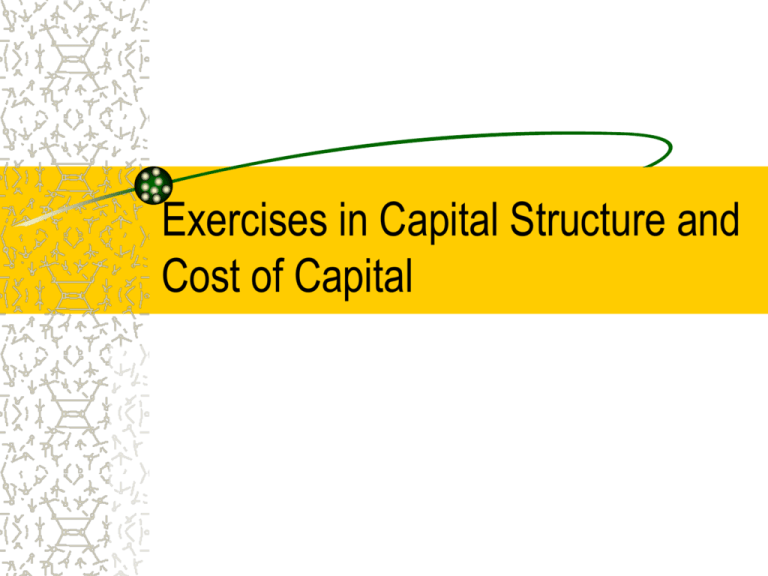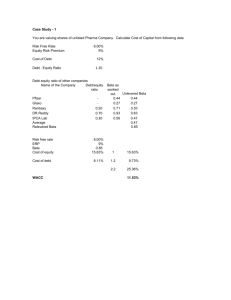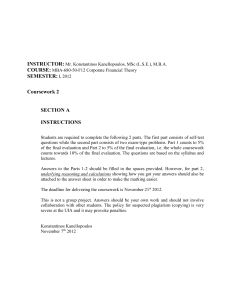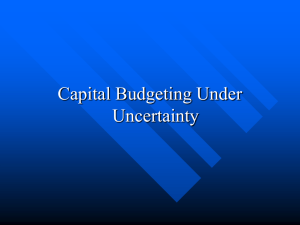Exercises in WACC and Capital Structure
advertisement

Exercises in Capital Structure and Cost of Capital Problem 1 Dreadnaught Industries has a debt/equity ratio of 2. Its WACC is 11 percent, and its cost of debt is 6 percent. The corporate tax rate is 35 percent. a. What is Dreadnaught's cost of equity capital? b. What is Dreadnaught's unlevered cost of equity capital? c. What would be cost of equity if the debt/equity ratio were 1? Problem 2 Astralite Corp. uses no debt. The cost of equity is 13 percent. If the current market value of the equity is $25 million, and the corporate tax rate is 35 percent, what is the WACC? What is the EBIT, if it occurs in perpetuity? The company has 10 million shares outstanding. If the firm decides to issue $10 million debt at 7% and retire shares worth $10 million, what will be the market value of the firm and the market value of the new equity? At what price will the firm repurchase the shares and how many shares will be repurchased? How do we calculate cost of capital? I. The Cost of Equity, RE A. Dividend growth model approach RE = D1 / P0 + g B. SML (CAPM) approach RE = Rf + b E x (RM - Rf) II. The Cost of Debt, RD A. For a firm with publicly held debt, the cost of debt can be measured as the yield to maturity on the outstanding debt. B. If the firm has no publicly traded debt, then the cost of debt can be measured as the yield to maturity on similarly rated bonds. Summary of Capital Cost Calculations III.The Weighted Average Cost of Capital A. The WACC is the required return on the firm as a whole. It is the appropriate discount rate for cash flows similar in risk to the firm. B. The WACC is calculated as WACC = (E/V) x RE + (D/V) x RD x (1 - Tc) where Tc is the corporate tax rate, E is the market value of the firm’s equity, D is the market value of the firm’s debt, and V = E + D. Question: How can we calculate the cost of capital of a division of a diversified firm? Answer We need to estimate the cost of debt and the cost of equity. The cost of debt is the YTM on the company’s bonds, and the cost of equity is estimated using CAPM: Re = Rf + b (Rm - Rf) The Comparable Company Approach Find a pure-play (or free standing, or single-segment) company of similar size in the same business, and its beta: b(fs) But we just learned that among other things, capital structure affects beta. If the two firms have the same capital structures, we can immediately apply b(fs) to our company. But suppose the capital structures are different. Then we need to adjust the b(fs) to reflect the capital structure of our company. Unlevered vs. Levered Beta Let b L = levered beta b U = unlevered beta (or the beta of the company if it had no debt, the pure asset risk coefficient) With taxes, the relation between the two betas is: b L = b U x [ 1 + (1 - Tc) (D/E)] Unlevering Beta When we estimate b L fs with linear regression we are estimating a levered beta. To adjust for the differences in leverage, we first unlever b L fs as : b U fs = b L fs / [ 1 + (1 - Tc) (D fs / E fs)] where D fs and E fs are the value of the debt and equity of the free standing firm (in market values!) Relevering Beta Once we calculate beta b U fs , we have a beta coefficient of a company with no debt. We relever it to reflect the capital structure of our company: b L c = b U fs x [ 1 + (1 - Tc) (D c / E c)] where D c and E c are the value of the debt and equity of our firm (in market values). Estimation Completed Then we estimate the cost of equity as Re c = Rf + b L c (Rm - Rf) and the WACC as: WACC = Re c [E c /(Ec + D c)] + (1-Tc)Rd [ Dc/(Ec + D c)] Assignment You are hired to value the brewing division of a publicly traded food company that will be sold to another firm. The division uses the same capital structure as the overall firm. It has a market value of equity of $1,250 million, and book value of $550 million. The company has the following bond issue outstanding: # Bonds 500,000 Coupon Rate 7% Book Value $1,000 Yield to Maturity Years to Maturity 6% 4 The risk-free rate is 4%, and the MRP is assumed to be 6% You also can find the observed (levered) betas, and capital structure ratios for the firms in the same industry.









